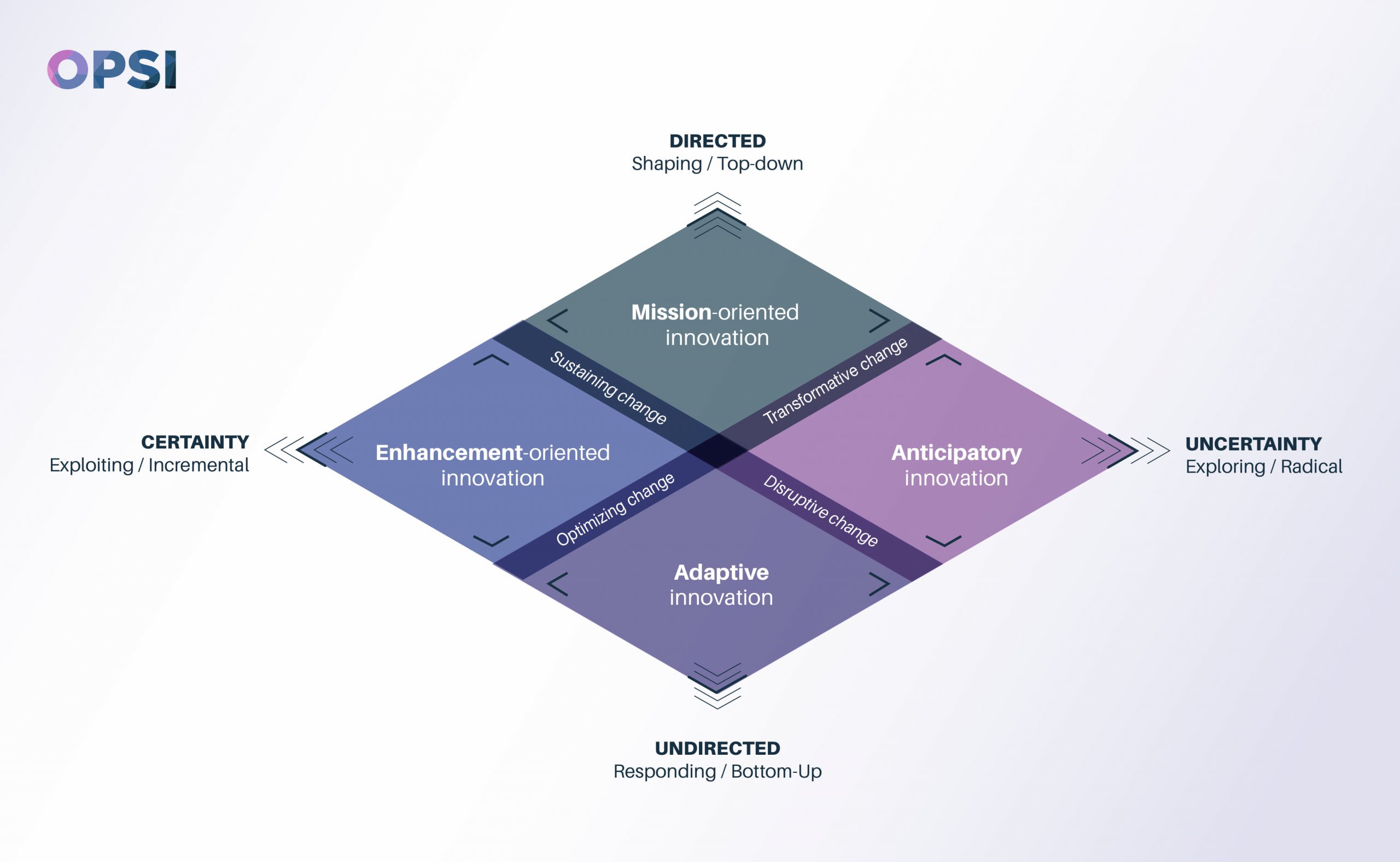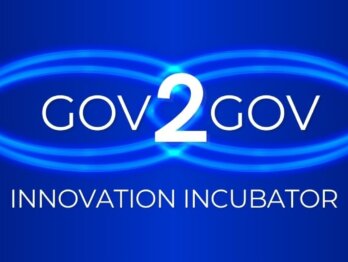Innovation facets part 6: Anticipatory innovation

In the last post in our innovation facets series, we went through what is involved in adaptive innovation. In this post, we take a look at the anticipatory innovation facet – what it is, what role it plays, how to support it, and the key considerations.
This post is us at OPSI “showing our work”, as this is still very much thinking that is evolving. Your feedback will help us in distilling the key messages, to ensure practical guidance for public servants everywhere. (You can now also hear more about the innovation facets model in our first ever podcast.)

Anticipate: “Guess or be aware of (what will happen) and take action in order to be prepared | act as a forerunner or precursor of”[1]
As we noted in the first post in the series, for anticipatory innovation:
- the key issue is exploration and engagement with emergent issues that might shape future priorities and future commitments.
- this facet has the potential to subvert existing paradigms. Very new ideas generally do not cohabit well with existing reporting structures, processes, and workflows, as how the idea will work in practice still needs to be teased out. Anticipatory innovation therefore generally requires being sheltered from core business and having its own autonomy, as otherwise the pressures of very tangible existing priorities are likely to cannibalise any resources that are dedicated to something preliminary and uncertain that is without any guarantee of success.
- Is demonstrated by a government funding investigatory work into artificial intelligence (AI) and its impact on service delivery. There is a high degree of uncertainty (What might be possible? How fast might that change as the technology evolves? How will people react to it?), and the exploration is unlikely to sit neatly with existing activity and operations.
- It is important because big changes are often easiest (and cheapest) to engage with and shape when they are still emergent and not locked-in.
My colleague Piret Tõnurist gives a quick overview of anticipatory innovation:
What does anticipatory innovation involve?
Anticipatory innovation is essentially about recognising and engaging with significant uncertainty about not only what works, but also what is appropriate or possible. It is about exploring new frames of reference and paradigms about how things can work, which then inform what should be done. Anticipatory innovation starts with the question of “How might emerging possibilities fundamentally change what X could or should be?”, with X being the relevant government response or activity.
At a working level, anticipatory innovation is about trying to reduce uncertainty through the exploration of new possibilities, to learn about how things could and/or should play out over time. It is supported by methods and practices such as horizon scanning, strategic foresight, futures thinking, speculative design, looking to lead users, regulatory (or other) sandboxes, mechanisms of challenge, and longer-term structured discovery-based challenges.
Examples of anticipatory innovation that we have seen include:
- research to not only discover what is possible but to help shape the future, such as funding projects to explore what electricity storage at the grid-scale might look like in the future
- the use of strategic foresight and planning to prepare for long-term electricity and water needs
- the use of a science fiction think tank to bring new perspectives and imagine new futures in order to challenge existing assumptions and provide new insight into what could be possible
- the use of speculative design to help “transport” public servants into the future, to explain and explore possible futures.
Anticipatory innovation can cut across all domains of government activity and is about testing assumptions and exploring radically different possibilities. Anticipatory innovation is activity with the intent of exploring what tomorrow might look like, what the implications might be, and what those implications might mean for current investment and activity (and even values).
What do you need to watch out for with anticipatory innovation?
Anticipatory innovation is not about predicting the future, but rather helping to shape how the future might play out, rather than being forced to respond to it when it arrives. However, the future is highly uncertain, and can take many twists and turns. Investment in anticipatory innovation can therefore be challenging, as the cost benefit equation is the least uncertain of all of the facets. Most of the time, the benefits of anticipatory innovation are only clearly seen in absentia – i.e. when no anticipatory innovation has happened, and there are then issues that arise, such as a lack of preparation for the major changes brought by social media to the information ecosystem surrounding politics and citizen engagement.
Some of the other issues particular to this facet are:
- Disconnection from core business. Anticipatory innovation can be seen as something frivolous, esoteric or removed from the day-to-day pressures and priorities. This can lead to resentment or distancing of the work, as it is not seen as relevant.
- Out-in-front. Anticipatory innovation can sometimes be too far out in front of the curve, and thus misinterpreted or simply not understood. This can harm the ability of anticipatory innovation to meaningfully influence the present.
- Too big picture. Anticipatory innovation can be seen as too removed or distant from what matters, meaning that the work may not be engaged with.
- Challenging values. By calling into question the current state, anticipatory innovation can challenge people’s beliefs and assumptions about how the world works, and the place of them and their work within it. Due to this, anticipatory innovation can be actively resisted or worked against, being seen as an attack on existing values.
How does anticipatory innovation fit within a portfolio?
To be effective over the longer term, any organisation or system will require a portfolio approach in its investments and efforts. In an uncertain world, you cannot predict the type, scope or direction of change that you will be confronted with. Therefore governments need to invest in multiple strategies if they are to both avoid being blind-sided, and so that they have a range of choices available to them in how to respond.
So how does anticipatory innovation fit within a portfolio approach?
Anticipatory innovation is about picking up on weak signals and engaging with them before a new course or paradigm is locked-in. Anticipatory innovation therefore is not so much about solving a problem, but about trying to understand if and how there might be a problem. This facet is the most difficult to demonstrate the return-on-investment, as without a counterfactual it is hard to say “If we had not done this, then X would have happened”. This difficulty means that anticipatory innovation is one that is generally least present within government portfolios, generally being focused in areas where there is a clear and recognised cost to being surprised (e.g. defence, agriculture, cyber-security, health).
We suggest that in a world with significant changes and high uncertainty in technological, social, political and economic domains, that anticipatory innovation is probably underweight in most government portfolios.
This is not to recommend that anticipatory innovation can or should be done everywhere or by everyone. There is a need to deliver on existing priorities. However, in the absence of sufficient anticipatory innovation, governments are unlikely to have access to a satisfactory range of choices about how to respond to some significant shifts.
What are the likely preconditions needed for anticipatory innovation?
In order for anticipatory innovation to occur, several factors are necessary:
- Structural autonomy. Anticipatory innovation is about different possibilities, and thus sits uncomfortably with delivering on existing and thus very tangible priorities. Where anticipatory activity is not shielded structurally, more immediate priorities are likely to always have pre-eminence.
- Political or institutional cover. Being about weak signals and exploration of potentially radically different possibilities means that anticipatory innovation can be seen as frivolous or even fanciful. Topics like artificial intelligence or the risks of automation may throw up weird ideas. Without some form of political coverage or institutional legitimacy, such activity is unlikely to last.
- Longer-term commitment. Making significant progress with anticipatory innovation will usually not occur quickly, as it requires new knowledge, mixing different perspectives and capabilities, the exploration of multiple potential options, and investment to help shape preferred futures.
How can anticipatory innovation be supported?
What is helpful to anticipatory innovation, rather than essential? We think there are some things that are especially relevant to supporting the facet of anticipatory innovation:
- Having a clear sense of consequence, such that the general risks and pitfalls of being blindsided and caught unprepared are understood and appreciated
- Giving explicit freedom to consider the unimaginable, to help ensure that more radical ideas can not only be considered but actively explored
- Encouraging unconventional partnerships and relationships, so that there is the room to engage with very different perspectives and to cultivate interactions with others whose capabilities may not seem immediately relevant.
How to sustain anticipatory innovation in the long-term?
To sustain anticipatory innovation as a practice/portfolio component, it is valuable to consider:
- Ensuring a clear line of sight with relevant decision makers, so that the work does not become disconnected or isolated from what matters.
- Involving senior leaders in anticipatory processes to help build their understanding of how it can be valuable.
- Creating a ready catalogue of examples and cases where there has been a failure to have developed options in advance, and that have resulted in crises, so that there is proxy evidence for why anticipatory innovation is necessary.
What can derail anticipatory innovation?
Each facet is vulnerable to being jeopardised in different ways. Anticipatory innovation can be disrupted or derailed by:
- Tying the work to specific indicators/measurement and/or focussing on the very practical, and thus cutting off the exploration of radical possibilities
- Making the anticipatory work compete with business-as-usual activity, which, all other things being equal, will always have predominance, given that reporting, processes, and structures will have developed to support this core work. Business-as-usual will cannibalise the resources from anticipatory innovation unless they are shielded in some way
- Not defending or valuing “out-there” thinking, and thus ensuring that anything that comes out of the anticipatory work will gradually start to converge with the norm in response to the inevitable scepticism (“But what evidence do you have this is going to happen?”) from other areas.
What are the signs that the innovation activity is transitioning to another facet?
In our innovation facets model, we note that innovation activity can, over time, move from one to another. Some signs that anticipatory innovation activity is transitioning to the other facets include:
- Towards enhancement-oriented innovation: Greater attention starts to be paid to how things are being done, rather than what might be possible. At an individual project level, this may be seen when the uncertainty has been dramatically reduced, and now the concern is about how to streamline and augment the innovation. At a portfolio level, this may occur when there has been a decision or choice made about how things should play out, and now the concern is with making it work as best as possible (e.g. when there has been exploration of different possible scenarios to do with the sharing economy, and then a choice has been made about how to proceed).
- Towards mission-oriented innovation: There is a move towards focusing on a specific ambition, rather than considering different possible futures. At an individual project level, this may be seen when the anticipatory innovation process has led to an identification of a preferred future, and now the effort shifts to seeing how that can be achieved. At a portfolio level, this may occur when there is a shift at a political level from exploring what futures society may wants, to advocating for very specific goals.
- Towards adaptive innovation: Innovative effort shifts from thinking about what the future could be, to focussing on what the future is showing itself to be. At an individual project level, this can occur when the project has revealed that the future is already somewhat “locked-in” and therefore effort is better spent adapting to it, than trying to shape it. At a portfolio level, this may be seen when there is no appetite for trying to shape the possibilities available, but rather a preference for adapting to it (e.g. there is a lack of political ambition or capital to engage with large scale changes when there are pressing immediate concerns about how to adapt to change on the ground).
An ongoing dialogue
The facets model has come out of our work with public servants from across different countries, and is a work in progress, with a number of hypotheses still to be fully tested.
Our aim is to help make practical sense of innovation for public servants, and so we value hearing from practitioners about their experiences and whether we’re hitting the right note. If you have any feedback, we welcome your comments, or you may wish to share your thoughts with us by email or on Twitter.
[1] Two of the definitions of anticipate, https://en.oxforddictionaries.com/definition/anticipate












